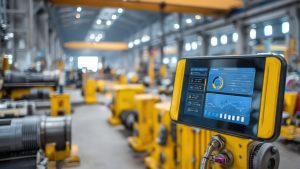In modern-day fierce commercial enterprise global, simply preserving up isn’t always enough. To thrive in the aggressive international panorama, you have to stay ahead. This is particularly genuine in production, a subject constantly reshaped by way of new thoughts and tech. Embracing manufacturing innovation for aggressive advantage is now not elective – it is vital for organizations searching for more than simply survival. It’s about locating higher, quicker, and smarter methods to make matters matter. However, it’s no longer pretty much vivid new tech. It’s about rethinking your entire method—how you design, produce, and deliver.
This means exploring things like robots building products alongside human workers, factories humming with real-time data, and products designed in hours instead of weeks. Sound overwhelming? It would not be. This publication will discover this transformation and how producers cannot best live to tell the tale but virtually thrive in these new surroundings.
Key Areas Transforming Manufacturing
We’re seeing game-changing technologies popping up, driven by a need for efficiency and continuous improvement. Think self-riding robots with exceptional-tuning assembly strains or three-D printers cranking out custom-designed parts on call. These technologies are rapidly becoming must-haves, not fine-to-haves, for keeping a competitive edge and improving product quality.
Advanced Automation and Robotics: Robots Aren’t Taking Over, They’re Lending a Hand
Two key players are reshaping the manufacturing game:
- Robotic Process Automation (RPA): Imagine software robots coping with one’s tedious, repetitive obligations, freeing your group to recognize complicated problems. That’s RPA in action, boosting precision, speed, and flexibility in production lines. This technology has a critical role in automating tasks and driving efficiency.
- Collaborative Robots (Cobots): Cobots work hand-in-hand with human operators, now not changing them. This collaboration is designed to enhance both productivity and protection.
A Deloitte study found that these “autonomous robots can be used to improve the speed and efficiency of routine operations, particularly in warehousing and manufacturing spaces.” This shows just how important this kind of technology is becoming for businesses today. Imagine robots taking on the more physically demanding or dangerous tasks, keeping your team safe and sound. It’s a complete win-win. This shift in aid allocation allows human ingenuity to be better utilized for obligations that require creativity and hassle-fixing.
Digital Transformation: Embracing the Power of Data and Connectivity
The manufacturing industry is swimming in information. Smart organizations use these statistics through data analytics and statistics collection to make higher choices, enhance performance, and streamline operations. Digital transformation isn’t always about fancy gadgets; it’s about working smarter now, not more difficult.
- Smart Factories: Imagine factories in which machines communicate with each other, sharing real-time information in the entirety, from manufacturing rates to electricity utilization. That’s the strength of smart factories, powered with the aid of the smart manufacturing unit market and fueled via the industrial net. These factories utilize digital tools and systems for continuous learning and process improvement.
- Cloud Computing: Cloud computing gives corporations immediate access to the statistics they want from everywhere within the globe. Think of it like having a giant, shared brain for your whole operation. Plus, it’s super scalable—need more power? Just add more clouds. This makes collaborating with teams across multiple locations easier than ever.
It’s no wonder that, as a document from the D2N2 Growth Hub states, “Manufacturers ought to embody generation and digitization.” The capability to streamline operations, increase performance, and improve decision-making is certainly too fantastic to ignore. This proactive approach to adopting new digital structures helps companies live aggressively and adapt as technology evolves.
Additive Manufacturing (3-D Printing): Printing Parts, Not Pages
Remember those clunky antique printers that could best churn out documents? Three-D printing is not anything like that. This recreation-changing tech permits you to “print” three-dimensional objects. However, its use extends far beyond creating easy prototypes, with applications ranging from healthcare to aerospace.
- Rapid Prototyping: No more ready weeks or even months to test new designs. 3-D printing offers superb-fast, price-powerful prototyping, accelerating the complete layout system. You could make tweaks and iterate hastily without breaking the financial institution.
- Customized Production: Need a unique part for a particular machine? 3-D printing says, “No trouble.” It unlocks the ability for personalized manufacturing, permitting producers to cater to particular patron desires in no way earlier than. This empowers organizations to offer bespoke answers, enhancing their competitive benefit.
Artificial Intelligence (AI) and Machine Learning (ML): Putting Data to Work
We are growing a notable amount of statistics, and AI and device mastering give us the equipment to interpret those facts and use them to optimize operations. AI and ML are reworking how manufacturers function, permitting information-driven choices and leading to greater green techniques.
| Benefit | Description | Example |
| Predictive Maintenance | Anticipating device screw-ups earlier than they occur to reduce downtime and preservation charges. | Sensors on a gadget accumulate facts about its performance. The AI gadget analyzes this information to expect when an element is probable to fail, making an allowance for proactive renovation and decreasing the risk of steeply-priced unplanned downtime. |
| Quality Control | Automating the detection of defects to make certain high-product quality requirements. | AI-powered cameras inspect the merchandise at the production line, identifying even minor defects that are probably ignored by using the human eye. This results in improved product quality and reduced waste. |
As mentioned through McKinsey & Company, one of the key movements procurement leaders can take is to “construct an agile procurement characteristic with more potent hyperlinks to internal and outside companions.” Embracing these technological improvements allows us to obtain that very agility.
Sustainable Practices: Good for Business, Great for the Planet
Being environmentally conscious is simply the right commercial enterprise nowadays. And it is going beyond the usage of recycled paper within the replica room. Today, sustainable practices are revolutionizing manufacturing processes and driving performance at the same time as minimizing environmental impact.
- Green Manufacturing: Reducing an agency’s environmental impact via using greater eco-friendly materials and power-green manufacturing strategies is what Green Manufacturing is all about.
- Circular Economy: What if waste wasn’t virtually wasted? A round financial system specializes in minimizing waste by way of repurposing and recycling materials on every occasion feasible. This approach aligns with the growing customer demand for sustainable products.
Gartner suggested that “businesses are making aggressive and strategic sustainability goals to enhance their logo reputation, make certain regulatory compliance, and enhance aid efficiencies.” Consumers are much more likely to choose brands that align with their values, making sustainability not simply ethically sound but additionally a smart enterprise flow.
But How Does Embracing Innovation Give Me an Edge?
In a global economy in which alternative is the only constant, manufacturers who face up to innovation could be left behind. Imagine being a corporation still counting on handwritten ledgers while computers were introduced. It’s not just about new tech but also new business models, approaches to problems, and even organizational structure.
A business can not only keep pace with rivals but surge ahead by implementing innovative processes and adopting new technologies. They’re better equipped to handle unexpected challenges. The truth is embracing manufacturing innovation for competitive advantage is essential to survival in today’s rapidly changing business landscape.
Here’s How Innovation Delivers That Winning Edge
- Enhanced Efficiency and Productivity: This includes making operations leaner, finding efficiencies in processes, and minimizing wasted material. More output with less input – who wouldn’t want that? It involves optimizing energy consumption and streamlining production speeds.
- Improved Product Quality: Consistently higher-quality products with fewer flaws translate to happier customers. Increased efficiency and lower production costs, without sacrificing quality? Sign us up. This leads to greater customer satisfaction and brand loyalty.
- Cost Reduction: This means automating operations for smoother production flows and discovering opportunities to reduce production costs without cutting corners. This can include reducing waste, optimizing strength intake, and improving the efficiency of manufacturing strategies.
- Increased Agility: By embracing alternate, corporations grow to be greater nimble, able to adjust on a dime to new market trends or moving consumer options. The capability to react fast to these adjustments is helpful and lets organizations stay ahead of the curve.
- Market Differentiation: Innovative companies are recognized for bringing exciting and unique offerings to clients. They aren’t afraid to be the “first”—and o often attain the monetary rewards of forging a new direction. Being a pacesetter in product innovation establishes the corporation as a trendsetter in their industry.
Sure, Sounds Great. But… It’s Complicated, Right? It’s Not Always Easy, Is It?
Jumping head-first into innovation can appear frightening. The truth is, that innovation is an ongoing technique, and continuous innovation is prime to staying beforehand within the ever-evolving manufacturing panorama.
Obstacles to Innovation:
You’ll likely face some common challenges:
- Funding New Ideas: This means overcoming the initial cost barrier and developing sound investment strategies for continued innovation. Embracing innovation regularly calls for widespread financial funding, and groups need to carefully recollect their return on investment.
- Integration Headaches: It’s crucial to make certain new technology seamlessly integrates with present structures to maximize their effectiveness. Integrating modern technology often requires a complete overhaul of present structures, leading to ability compatibility problems.
- Training and Building a Skilled Workforce: You’re going to want employees professional in advanced tech to genuinely make this work. This venture highlights the importance of ongoing schooling and improvement possibilities for workers. The capabilities hole in production is developing; attracting and preserving personnel with the vital skillsets for these high-tech jobs may be a pinnacle of precedence.
- Managing the Change: Organizational resistance to exchange is inevitable. Cultivating surroundings that embrace innovation calls for endurance, information, and a willingness to conform. Leadership plays a vital function in communicating the blessings of innovation and presenting the vital aid for its hit implementation.
Think of a commercial enterprise figuring out whether or not to put money into new machinery or stick with present equipment.
Sticking with the known might seem safer, especially given the considerable expense. But what happens when those machines break down or, even worse, become obsolete? Failing to invest in progress means risking being overtaken by rivals. Remember the company using ledgers in a world of computers?
Case Studies: Innovation Success in Action
These companies took the plunge and emerged as leaders by embracing innovation:
- Automation & Robotics: FANUC, a global automation giant, uses robotics to increase production efficiency, setting the standard for advanced automotive manufacturing. Think streamlined assembly lines and high-precision welding done by robot teams.
- Digital Transformation: Siemens is redefining manufacturing with its “virtual factory”—a c continuing integration of virtual layout, simulation, and actual-time data for remarkable management and flexibility. This method bridges the gap between the virtual and actual worlds, resulting in faster manufacturing instances, improved high-quality manipulation, and the capacity to respond to market changes plenty quickly. Their success has helped the smart manufacturing unit market grow extensively over the last few years.
- Additive Manufacturing (3-D Printing): Boeing, the aerospace innovator, makes use of 3D printing for faster prototyping and lighter, more potent aircraft additives, demonstrating its transformative ability in a high-stakes industry. External partnerships provide entry to present-day 3-D printing technology and knowledge.
A Look at Tomorrow’s Factory Floor
What’s next? Well, if contemporary tendencies are whatever to move to utilize—interesting times. Here are trends shaping day after day in today’s production world:
- Cutting-Edge Tech: Imagine a factory ground in which workers carrying Augmented Reality (AR) headsets interact with virtual blueprints superimposed over real-global items. This is one ability software of augmented truth, presenting practical answers for complicated meetings and renovation obligations. It’s additionally a key part of the “clever manufacturing facility,” which leverages technology like IoT, sensors, and artificial intelligence, connecting all factors of production in an intelligent network. Advanced analytics derived from these facts can be used for predictive protection, great manipulation, and optimizing strength intake.
- Smart Manufacturing Evolves: As increasingly manufacturers embrace the electricity of AI, assume to peer a shift from mass production towards mass personalization. Imagine your organization churning out thousands and thousands of specific versions of a single product, every flawlessly customized to characterize patron possibilities. Pretty cool, right? This paradigm shift in production allows for extra flexibility and responsiveness to individual patron needs.
FAQs About Embracing Manufacturing Innovation for Competitive Advantage
How can I persuade my team to include innovation?
Start by highlighting the advantages—how it may make their jobs less difficult, enhance product quality, and make a contribution to the employer’s success. Share success tales of different manufacturers and provide opportunities for your group to learn about and experiment with new technologies. Encourage a subculture of open communication and idea sharing, making it clear that everyone has a position to play in the innovation procedure.
What are the first steps to turning into a greater revolutionary manufacturer?
Begin by identifying areas where innovation can make the most important impact. Is it streamlining production, enhancing product quality, or reducing waste? Once you’ve identified your priorities, begin small. Experiment with pilot projects earlier than making huge-scale adjustments. Don’t be afraid to try to find external partnerships; they can provide treasured understanding and get entry to technologies you might not have in residence.
How can I Stay informed about modern-day production improvements?
Attend enterprise conferences, study exchange guides, and follow thought leaders and businesses on social media. Network with different specialists, be part of industry institutions, and remember partnering with universities or research institutions to stay ahead of the curve.
Conclusion
It’s no secret—the manufacturing global is undergoing a big transformation. Technologies that were regarded as something from Star Trek just a decade ago, like synthetic intelligence and robotics, are transforming the enterprise at a rapid tempo. Embracing manufacturing innovation for aggressive benefit is the path to now not simply keeping up with these trends but becoming a pacesetter. Those willing to conform, examine, and embrace the possibilities this thrilling new generation brings are going to win. Innovations in areas just like the supply chain are vital, enhancing efficiency and responsiveness in ways previously unimaginable. As the era evolves, the manufacturing landscape will continue to shift, making non-stop studying and a proactive approach critical for success in this aggressive international market.



